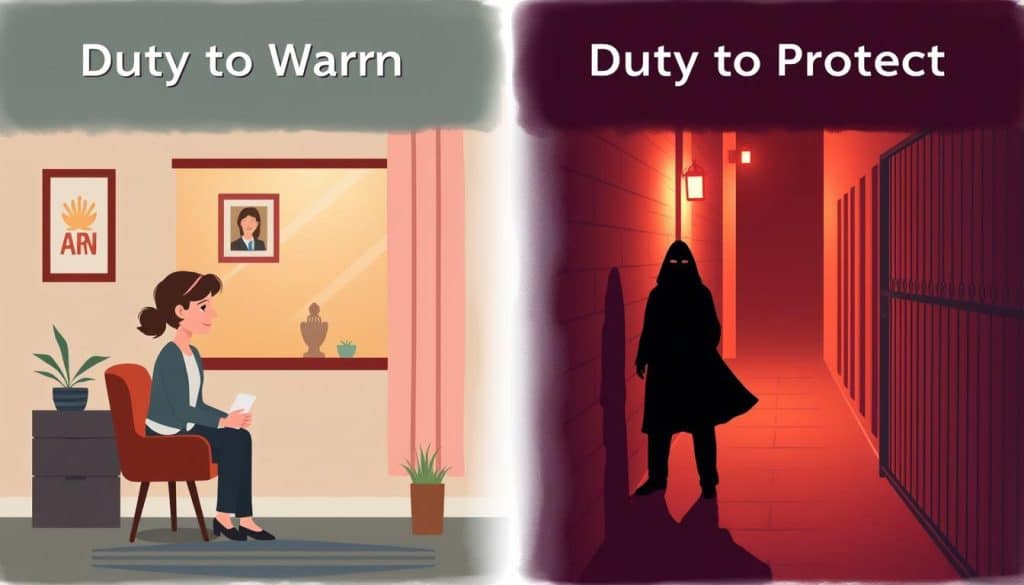As social workers, we have a big responsibility. We must follow our profession’s core values, like keeping client secrets and keeping people safe. The Tarasoff v Regents of the University of California 1976 and 1974 cases have greatly influenced these important ethical and legal rules in social science. When you’re getting ready for the ASWB exam, knowing about Tarasoff, the duty to warn, and the duty to protect is key. It will help you deal with the complex situations you might face.
The Tarasoff case is a key moment in mental health history. It changed how professionals protect the public from violence. This case started in 1969 at the University of California, Berkeley. A tragic event happened between Prosenjit Poddar and Tatiana Tarasoff.
Poddar, a UC Berkeley student, told a university psychologist he wanted to harm Tarasoff. But the psychologist didn’t warn Tarasoff or take action. Sadly, Poddar later killed Tarasoff.
The Tarasoff case led to two major legal decisions. The first, in 1974, said mental health professionals must warn potential victims. The second, in 1976, went further. It said professionals must protect potential victims, even if it means breaking confidentiality.
These decisions changed mental health work a lot. Now, therapists and counselors must protect the public from violent clients. They have to balance keeping client secrets with their duty to protect others.
The Tarasoff decision has sparked some debate. Some, like Donald N. Bersoff of the American Psychological Association, think it puts too much stress on warning others. They worry it might hurt the trust between clients and therapists.
“The Tarasoff ruling was controversial, emphasizing the importance of client confidentiality and advocating for breaching it only as a last resort.”
Despite the debate, the Tarasoff case is a crucial moment in mental health history. It has shaped the legal and ethical duties of professionals for many years.
As social work professionals get ready for the ASWB exam, knowing the Tarasoff doctrine is key. It’s important to understand the reporting and notification rules. This knowledge is crucial for doing well on the exam.
The Tarasoff doctrine kicks in when a client threatens to harm someone specific. It’s vital to know how to assess danger and spot Tarasoff triggers. Exam questions often test your ability to fulfill your duties when a Tarasoff obligation is met.
Many exam questions ask you to decide if Tarasoff notification is needed. For instance, if a client has a violent boyfriend, you must seek legal advice and talk to a supervisor. This is because the situation requires you to warn or protect.
| Scenario | Correct Response |
|---|---|
| Client threatens violence against an identifiable victim | Tarasoff duty to warn or protect is triggered |
| Client is the potential perpetrator of violence | Tarasoff duty is not triggered, but other reporting requirements may apply |
| Client’s probation officer should be notified | Incorrect, therapists are not required to report this information |
When you face Tarasoff questions, it’s important to weigh confidentiality against public safety. Knowing your limits is also key. Use your knowledge of Tarasoff to think critically and find the right answers.
“Preparing for the ASWB exam requires a deep understanding of the Tarasoff reporting requirements and notification protocols. Mastering these concepts is essential for success.”
In social work, the Tarasoff doctrine has two key principles: the duty to warn and the duty to protect. It’s vital for social workers to grasp these differences. This helps them handle tough ethical situations and get ready for certification exams.
The Tarasoff duty to warn social work means telling potential victims about threats. This happens when a client says they will harm someone specific. Social workers must then warn the person at risk, which might mean calling the police or the person threatened.
The Tarasoff duty to protect is wider. It’s about keeping the intended victims safe. This can mean warning them, telling the police, or other steps. Social workers might also start commitment hearings or tell mental health experts about threats.
| Duty to Warn | Duty to Protect |
|---|---|
| Requires verbal notification to potential victims | Involves broader actions to safeguard intended victims |
| Triggered by a client’s credible threat against a specific individual | Can involve various interventions, such as initiating commitment hearings or informing mental health evaluators |
| May involve contacting the authorities or the person being threatened | Ensures comprehensive protective measures are in place |
Knowing the difference between the duty to warn and the duty to protect is key. It helps social workers deal with Tarasoff-related issues better. They can keep their clients and the community safe with more confidence and integrity.

“The Supreme Court ruled in the case of Swidler & Berlin and James Hamilton v. United States in 1998 that attorney-client privilege survives a client’s death, even in connection with criminal cases, emphasizing the legal protection of communication between a client and a lawyer.”
As social workers, we must know the legal and professional duties tied to Tarasoff reporting. The Tarasoff doctrine requires us to warn or protect others from harm. This rule changes a lot from state to state in the U.S.
It’s key for us to learn about Tarasoff laws in our states. Thirteen states don’t have these laws yet. But most states have rules that tell us what to do and what not to do. Knowing these laws helps us provide better care for our cleints.
Keeping good records is very important in Tarasoff cases. We need to write down our risk checks, actions, and why we might break confidentiality. Good records protect us and show we’re doing our job right.
Figuring out how risky a client is is hard. We use special rules to look at their past, current mood, and any threats. This way, we can help them and keep everyone safe.

By knowing our state’s Tarasoff laws, keeping detailed records, and using good risk checks, we can handle Tarasoff reporting well. After all, knowing when to complete a Tarasoff report is not just sill to be mastered for the ASWB exam. It’s also key to giving our clients and communities the best care.
Assessing client dangerousness is key for social workers. It’s vital to know about their past actions and current thoughts. They should ask about any violent history and if they plan to harm others now.
Understanding if their dangerous behavior is due to mental illness or impulse control is crucial. Regular checks and talks with colleagues are important. This ensures a complete assessment and the right steps for high-risk clients.
| Statistic | Value |
|---|---|
| Most associates have little to no professional experience with clients who are a danger to others. | – |
| Therapists may face confusion around their legal responsibilities, particularly on the California law and ethics exam. | – |
| The Tarasoff ruling by the California Supreme Court in 1976 established the duty to protect. | – |
Doing a detailed assessment of client danger and violence risk is crucial. It keeps everyone safe. By getting the right info, looking at mental health, and talking often, social workers can prevent harm. They can also offer the right help.
As social work professionals, we face a tough choice. We must protect client confidentiality while ensuring public safety. The Tarasoff ruling has made this challenge clear, asking us to weigh the need to break confidentiality when a client might harm someone.
The Tarasoff decision has brought a big challenge to social work. We must keep our clients’ trust and confidentiality. Yet, we also have to warn potential victims and prevent harm when a client might be violent.
This dilemma is hard because breaking confidentiality can hurt the therapy. Clients might lose trust, making treatment less effective. Social workers must balance these needs, always choosing what’s best for the client and the public.
In Tarasoff situations, social workers need a careful decision-making process. This involves assessing the risk, looking at the client’s history and the threat’s credibility. Getting advice from colleagues or legal experts is also important.
Deciding to break confidentiality should be a last resort. It should only happen after trying all other options and when public safety is at risk. The decision must be well-documented, showing the social worker’s commitment to ethics and the law.
By carefully navigating these ethical challenges, social workers can meet the highest professional standards. They protect the vulnerable while respecting privacy. This requires empathy, hard work, and a strong commitment to the well-being of all.
Understanding the Tarasoff principle is key for both passing the ASWB exam and practicing social work ethically. We’ve looked at the Tarasoff case’s history, important concepts, and legal and ethical sides of this ruling.
Even though Tarasoff situations are rare, being ready for them is vital. As you get ready for the ASWB exam, work on critical thinking. Apply Tarasoff principles to different scenarios. This will help you answer Tarasoff-related questions confidently and make ethical decisions in your social work career.
The Tarasoff doctrine is about finding a balance between keeping client secrets and keeping people safe. By getting this, you’ll be ready to give top-notch care, protect those who need it, and meet the social work profession’s highest standards. With this knowledge, you’re set to do well on the ASWB exam and be a more skilled, ethical social worker.